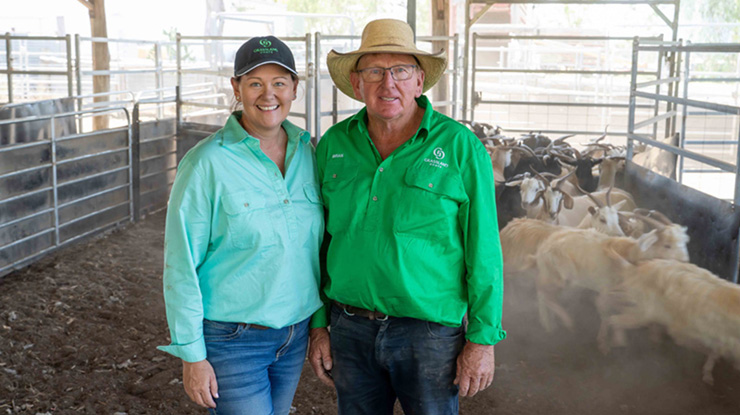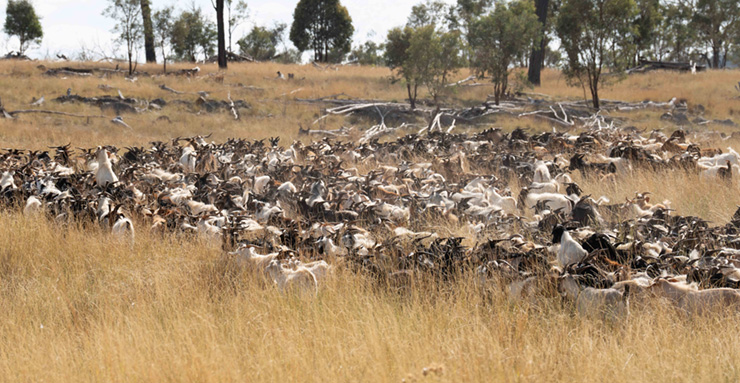 Keeleigh and Brian Allport
Keeleigh and Brian Allport
How goats built a thriving enterprise
When Brian and Keeleigh Allport first introduced goats to their cattle and sheep enterprise in 2018, it was part of an on-farm drought mitigation strategy to help better manage their vegetation.
“Basically, the cattle would go in and knock down the taller shrubs and weeds in paddocks that had been locked up, then the goats would go through and clear it,” Brian said.
From that modest start, the Allports have gone on to establish one of Australia’s premium goatmeat enterprises.
A new direction
Grassland Goats was established in 2019, primarily as a market for those bush goats they’d used on-farm. However, the Allports also saw an opportunity to spread their financial risk.
“To begin with, we were sending around 30 goats per week into the domestic market. These days, we’re regularly doing 400–500 a week, but that could rise to 1,000 goats a week during the Islamic festivals,” Keeleigh said.
To meet demand, the business has anywhere from 15,000–20,000 goats on hand at any time – including breeders, kids and backgrounders – mostly drawn from bush and rangeland goat blends crossed with Boer and Kalahari breeds.
On the rare occasion supply runs short, they rely on approved suppliers from western Queensland and NSW for additional rangeland and crossbred goat stock.
These animals are backgrounded for four weeks then processed through the Allports’ vertically integrated supply chain.
A multi-breed operation
While goatmeat is now their primary revenue driver, the Allports continue to run a cattle breeding and backgrounding business, with about 400 Santa Gertrudis and Angus/Hereford cross cattle.
“Beef cattle have always been our passion and I don’t think we’ll ever be able to give that up completely,” Brian said.
The business also runs between 1,000 to 2,000 sheep at any time and processes about 100 lambs each week.
“Our lambs are primarily sourced from our own breeding stock. When demand requires, we’ll rely on saleyards and hold those lambs for processing the following week or background them to fit into our system.”

The Allports draw on bush and rangeland goat blends crossed with Boer and Kalahari breeds.
Vertically-integrated supply chain
The Allports own and operate virtually every aspect of their supply chain from on-farm production to customer fulfillment.
“We are in control of everything from growing our feed to owning our livestock transport and the cold storage trucks used to deliver the meat,” Keeleigh said.
“The only aspect of the supply chain we don’t own is the abattoir – we use a third-party service kill and have our own staff on‑site in the chiller and packing rooms.”
The Allports employ their own halal slaughterer to ensure the meat is blessed and prepared in accordance with Islamic requirements. They also have quality assurance on‑site to check for any defects and make sure each carcase is tagged.
“We even have our own people there to pack the meat and handle customer order fulfillment so we’re sure the right product is allocated to the right customer.”
Traceability that’s always spot-on
The Allports’ electronic National Vendor Declaration (eNVD) journey started many years ago when they moved on from the paper books to become early adopters of the web‑based eNVD which enabled them to print out copies for their transporter.
These days, their consignments are completely paperless.
“Looking back, the NVD books were really inconvenient and costly. There was always the chance that we’d run out of forms at the last minute, or we’d forget to take them down to the yards on the day we were loading the stock,” Brian said.
They say the one big advantage of moving to fully digital consignments is the ability to adjust their delivery numbers when necessary.
“We try to count the animals, but loading goats isn’t easy and there’s always some that’ll rush through. Once they’re processed at the abattoir we can then go back and easily correct those numbers.”
That’s delivering a more accurate data collection for Grassland Goats’ reporting and making sure their traceability records are spot on.
The technology has also made it possible for producers such as the Allports to complete eNVDs from anywhere.
“With the eNVD, you’re basically carrying your consignment in your pocket,” Keeleigh said.
“You can do it from anywhere – and when I say anywhere, I mean anywhere.”
The couple had been working on an agricultural traceability project with the Export Council of Australia and were invited to attend a traceability symposium in Los Angeles, US, last year.
“While we were in California, travelling through Yosemite National Park, Brian was able to complete the eNVD while our team was on the ground loading trucks back a tour Gore property,” Keeleigh said.
“Why would you go back to the paper forms when you can do that?
“Looking back, I can’t believe we resisted making the shift to the eNVD because of our connectivity issues, but I’ll tell you what, we’d never go back now."
Watch to learn more about the Grassland Goats’ experience with eNVD below.



